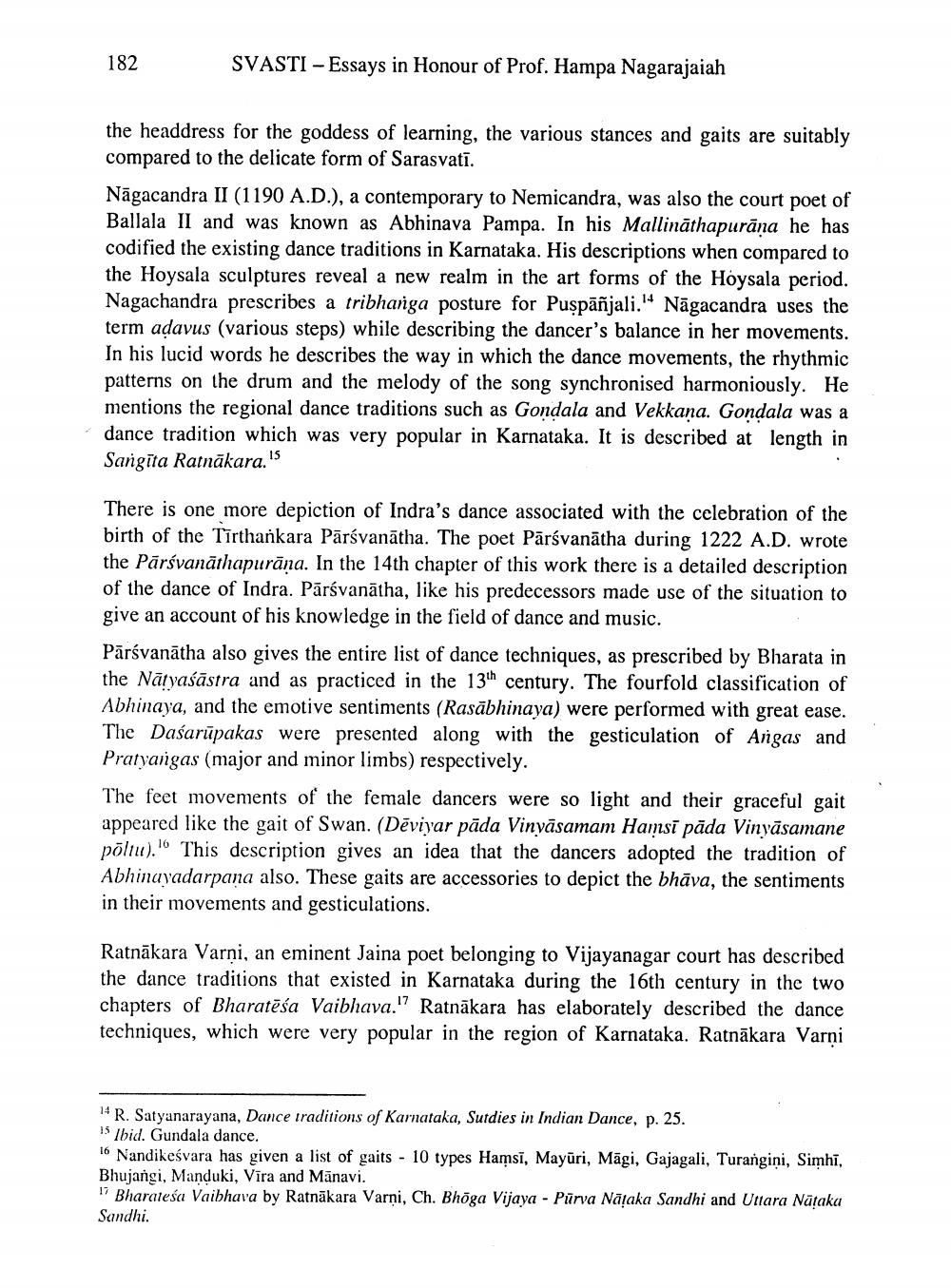________________
182
SVASTI - Essays in Honour of Prof. Hampa Nagarajaiah
the headdress for the goddess of learning, the various stances and gaits are suitably compared to the delicate form of Sarasvati.
Nagacandra II (1190 A.D.), a contemporary to Nemicandra, was also the court poet of Ballala II and was known as Abhinava Pampa. In his Mallinathapuräna he has codified the existing dance traditions in Karnataka. His descriptions when compared to the Hoysala sculptures reveal a new realm in the art forms of the Hoysala period. Nagachandra prescribes a tribhanga posture for Puspäñjali." Nägacandra uses the term adavus (various steps) while describing the dancer's balance in her movements. In his lucid words he describes the way in which the dance movements, the rhythmic patterns on the drum and the melody of the song synchronised harmoniously. He mentions the regional dance traditions such as Gondala and Vekkana. Gondala was a dance tradition which was very popular in Karnataka. It is described at length in Sangita Ratnakara.'
There is one more depiction of Indra's dance associated with the celebration of the birth of the Tirthankara Pärśvanätha. The poet Pärśvanätha during 1222 A.D. wrote the Pärsvanathapurana. In the 14th chapter of this work there is a detailed description of the dance of Indra. Pärśvanätha, like his predecessors made use of the situation to give an account of his knowledge in the field of dance and music.
Pārsvanatha also gives the entire list of dance techniques, as prescribed by Bharata in the Natyasastra and as practiced in the 13th century. The fourfold classification of Abhinaya, and the emotive sentiments (Rasäbhinaya) were performed with great ease. The Dasarupakas were presented along with the gesticulation of Angas and Pratyangas (major and minor limbs) respectively.
The feet movements of the female dancers were so light and their graceful gait. appeared like the gait of Swan. (Deviyar päda Vinyasamam Hamsi päda Vinyasamane polu). This description gives an idea that the dancers adopted the tradition of Abhinayadarpana also. These gaits are accessories to depict the bhava, the sentiments in their movements and gesticulations.
Ratnakara Varni, an eminent Jaina poet belonging to Vijayanagar court has described the dance traditions that existed in Karnataka during the 16th century in the two chapters of Bharatesa Vaibhava." Ratnakara has elaborately described the dance techniques, which were very popular in the region of Karnataka. Ratnākara Varni
14 R. Satyanarayana, Dance traditions of Karnataka, Sutdies in Indian Dance, p. 25.
15 Ibid. Gundala dance.
16 Nandikeśvara has given a list of gaits 10 types Hamsi, Mayūri, Mägi, Gajagali, Turangini, Simhī, Bhujangi, Manduki, Vīra and Mānavi.
17 Bharatesa Vaibhava by Ratnakara Varni, Ch. Bhōga Vijaya - Purva Nataka Sandhi and Uttara Nāṭaka Sandhi.




